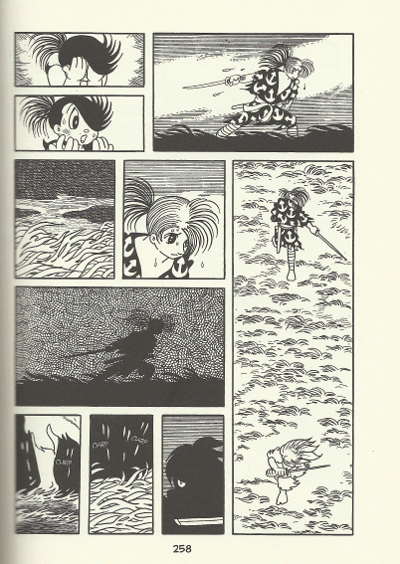Impressions of Dororororo- er, Dororo
This past week I finished reading Tezuka Osamu’s Dororo. I’ve read a few of Tezuka’s other works, including Apollo’s Song, Black Jack, and Ode to Kirihito, but I haven’t written about any of them partly because I can’t shake the feeling of audacity in passing judgment on someone of his stature (it’s for similar reasons I haven’t written about, say, Shakespeare). I’ll just shake off that feeling for now, though, and share my impressions of this one.
Dororo’s art is clean and relatively simple, if not rather cartoony. As a result, the action is always clear and the characters expressive. Though the cartoony style does aid in suspension of disbelief, which is especially helpful in the first couple chapters, it also clashes with the story’s darker and more violent moments. Now, this is Tezuka’s standard art style, and I wouldn’t go so far as to call it outright inappropriate, but I can’t help suspecting that a more realistic style would have served this story better. Tezuka also has a couple idiosyncracies that show up occasionally, namely reusing character designs from his older works and fourth-wall jokes. Though long-time fans may appreciate the cameos and the fourth-wall jokes are amusing enough, these distract from the main story without really adding anything significant, so again they may have best been left out.

Overall, though, Dororo is a visually appealing work, and my complaints here are minor. Where Tezuka really shines as a master of the comics medium is his use of panel layouts. He’s near-perfect in choosing how much space to devote to each action; where to move quickly through several small panels and where to give a full page to a single moment. Sensibly, most pages look fairly conventional; this isn’t some avant-garde work, and Tezuka generally only uses something special for scenes that deserve such treatment. Dynamic movements, for instance, often reach beyond the panel borders. Other times, panel layout will mimic the character’s movement, like when he uses a series of narrow fan-shaped panels to portray Hyakkimaru, one of the two protagonists, climbing across a rocky landscape (see right).
The story begins with a strong premise. A samurai makes a Faustian bargain for power with a group of forty-eight demons, who for payment each take one organ from his newborn son. The child is abandoned but discovered by a physician who, once he sees that the boy can survive, names him “Hyakkimaru” and makes a set of prosthetics so he can look and move around more-or-less normally (if you’ve read Black Jack, it’s a similar situation to Pinoko). Once he’s older, Hyakkimaru sets out to find and defeat the forty-eight demons to regain his lost organs. Along the way, he meets a boy named “Dororo,” an orphan and the world’s self-proclaimed greatest thief, who joins him on his journey.
Though both Hyakkimaru and Dororo receive a fair amount of character development, the bulk of the story is episodic and action-oriented. That’s fine, though, because the action is always exciting and each of the several demons the protagonists encounter is unique and interesting. The ending does come abruptly, and though Hyakkimaru does give a few words more or less summing up the story’s main theme, little is really resolved, so it’s not fully satisfying.

I did like Dororo’s main theme, which is essentially about accepting one’s destiny and thereby becoming a full person. For Hyakkimaru, of course, becoming a full person is literal, while for Dororo it involves accepting his parents’ final wishes for him and coming to terms with a secret about his identity, which I won’t spoil.
Dororo is published in North America by Vertical, who did their usual good job as far as print quality and binding. Dawn T. Laabs’s translation is readable throughout, though I’ll give my usual disclaimer that I can’t vouch for accuracy. They originally released this in three volumes, but I read the more recent omnibus edition, which unfortunately is heavy and rather unwieldy. Dororo is an excellent read, but I would recommend seeking out the three-volume edition.